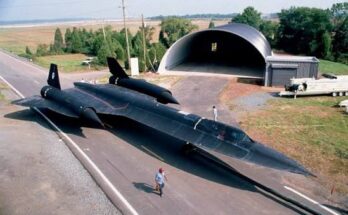
Disaster in the Skies: The 1994 Fairchild Air Force Base B-52 Crash
The 1994 Fairchild Air Force Base B-52 crash remains one of the most tragic and preventable aviation accidents in military history. This disaster occurred on June 24, 1994, when a Boeing B-52 Stratofortress, piloted by Lieutenant Colonel Arthur “Bud” Holland, crashed during an airshow practice flight, killing all four crew members aboard. The crash was captured on video, and the investigation revealed a series of critical errors that ultimately led to the loss of the aircraft. The accident underscored the dangers of reckless flying and the failure of leadership to address repeated safety concerns.
Background: The B-52 Stratofortress
The Boeing B-52 Stratofortress is a long-range, subsonic, strategic bomber that has been a key part of the United States Air Force since the 1950s. Known for its durability and versatility, the B-52 was originally designed to carry nuclear weapons during the Cold War but has since been adapted for conventional warfare. The aircraft has a wingspan of 185 feet and weighs over 488,000 pounds when fully loaded. While it is an engineering marvel, it was never designed for extreme aerial maneuvers, especially at low altitudes.
The Lead-Up to the Crash
The events that led to the 1994 crash can be traced back to years of reckless flying by Lt. Col. Bud Holland. Holland had a reputation for pushing aircraft to their limits, performing unauthorized and dangerous maneuvers. Despite multiple warnings from fellow pilots and officers about his risky flying style, he continued to operate with little intervention from his superiors.
One of the most concerning incidents occurred in 1991 when Holland executed an unauthorized low-level pass over a crowd at an airshow. The maneuver was well outside safety regulations, yet he faced no serious consequences. This pattern continued over the years, with multiple instances of unsafe flying, including excessive bank angles and steep turns that put both crew and aircraft in jeopardy.
Despite these warnings, Holland was still assigned as the pilot for the upcoming Fairchild Air Force Base airshow practice in 1994. The planned flight was meant to be a routine demonstration, showcasing the B-52’s capabilities in a safe and controlled manner. However, Holland once again attempted to push the aircraft beyond its limits.

The Crash: A Tragic Turn of Events
On June 24, 1994, Holland and his crew boarded the B-52 to conduct a final rehearsal for the airshow. The crew included Lt. Col. Mark McGeehan, who had previously raised concerns about Holland’s flying, but was unable to prevent his participation in the flight. Also on board were Lt. Col. Ken Huston and Col. Robert Wolff.
During the flight, Holland performed several aggressive maneuvers, including steep turns and low-altitude passes. As he approached the final turn around the control tower, he banked the aircraft at an angle exceeding 60 degrees—far beyond the safe operating limits of the B-52. The aircraft, already flying at low speed and low altitude, quickly lost lift and stalled.
Within seconds, the massive bomber spiraled out of control and crashed near the runway. A massive fireball erupted upon impact, killing all four crew members instantly. The entire crash was recorded on video, providing clear evidence of the reckless maneuvering that led to the disaster.
The Investigation and Findings
In the aftermath of the crash, the U.S. Air Force launched an extensive investigation. The findings confirmed that Holland had a long history of dangerous flying behavior and that multiple officers had raised concerns about his actions. Despite this, he had been allowed to continue piloting aircraft without any disciplinary action.
The report concluded that Holland was directly responsible for the crash due to his excessive bank angle and disregard for flight safety protocols. However, the investigation also pointed to failures in leadership and accountability. Senior officers had failed to take corrective action, allowing Holland to continue his reckless behavior unchecked.
One of the key lessons from the investigation was the importance of enforcing safety regulations and addressing concerns about dangerous behavior before it leads to tragedy. The Air Force implemented stricter oversight measures to prevent similar incidents from occurring in the future.
Lessons Learned and Legacy
The 1994 Fairchild Air Force Base B-52 crash remains a stark reminder of the consequences of reckless flying and the failure of leadership to address safety concerns. Several key lessons emerged from the tragedy:
1. The Importance of Accountability – Had superior officers acted on the multiple warnings about Holland’s flying behavior, the crash could have been prevented. Leadership plays a crucial role in maintaining safety and enforcing regulations.

2. Aircraft Limitations Must Be Respected – The B-52 is not designed for extreme aerial maneuvers. Pushing any aircraft beyond its operational limits can lead to catastrophic failure.
3. Crew Safety Should Always Be a Priority – Lt. Col. Mark McGeehan had reportedly attempted to keep his crew safe by implementing certain restrictions, but in the end, the Air Force’s failure to remove Holland from flight duty put all four crew members in danger.
4. Video Evidence and Training – The video footage of the crash has been used extensively in Air Force training programs to teach pilots about the dangers of reckless flying. It serves as a powerful visual lesson on the importance of adhering to safety protocols.
Conclusion
The Fairchild Air Force Base B-52 crash of 1994 was a preventable tragedy that resulted from a combination of pilot recklessness and leadership failures. The incident cost the lives of four experienced officers and served as a wake-up call for the Air Force regarding the importance of strict adherence to flight safety regulations.
Today, the crash is remembered as one of the most infamous examples of what can happen when warning signs are ignored. The lessons learned from this disaster continue to shape aviation safety protocols, ensuring that such a tragedy never happens again.


